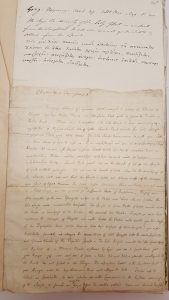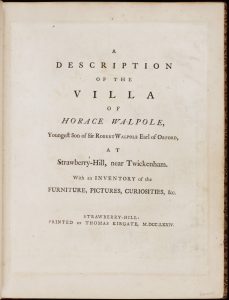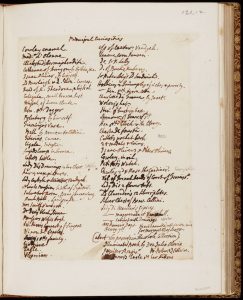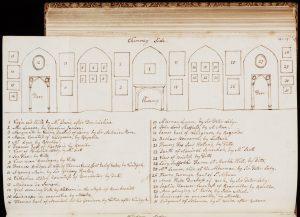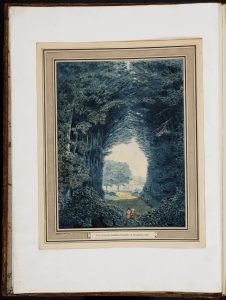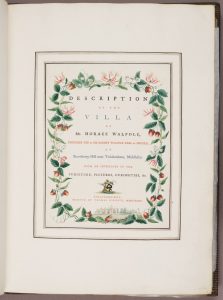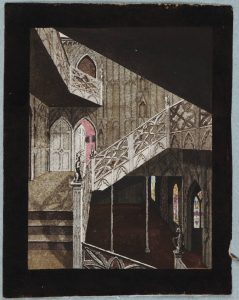24. Choice 14: Walpole’s Chattertoniana
by Wilmarth S. Lewis
“Coming back on the Olympic in 1925, I met Dr Edward Clark Streeter, to whom I later dedicated my Collector’s Progress. He had been at Yale twenty years ahead of me, had formed a fine library of medical history, and was then making his notable collection of weights. After I held forth on Walpole he looked at me quizzically and asked, ‘But what about the Marvellous Boy?’ He was quoting Wordsworth,
“‘Chatterton, the marvellous boy,
“The sleepless soul that perished in his pride.’
“This was the youthful genius, Thomas Chatterton, who committed suicide in his eighteenth year, a victim of opium as well as of pride and whose brief life fills twenty columns in the Dictionary of National Biography, as compared to Boswell’s sixteen and Walpole’s eleven. While we walked the decks of the Olympic I explained to Ned Streeter that I couldn’t collect Walpole if I wasn’t convinced he was innocent of Chatterton’s death and Ned accepted his innocence when I finished.
“The Choice in this chapter is Walpole’s collection in four volumes of sixteen pieces dealing with Chatterton. To appreciate them one must know the boy’s story and how he, a precocious adolescent in Bristol, the son of a poor schoolmaster, secured a special place in English literature.
“In 1776 Chatterton, aged sixteen, sent Walpole ‘The Ryse of Peyncteynge yn Englande, wrote bie T. Rowleie, 1469, for Mastre Canynge.’ Rowley was a fifteenth-century monk of Bristol invented by Chatterton who allegedly composed a treatise on ‘peyncteynge,’ that might, Chatterton wrote Walpole, be ‘of service to you in any future edition of your truly entertaining Anecdotes of Painting.’ He added ten explanatory notes to ‘The Ryse of Peyncteynge.’ The first of them was on Rowley whose ‘Merit as a biographer, historiographer, is great, as a poet still greater . . . and the person under whose patronage [his pieces] may appear to the world, will lay the Englishman, the antiquary, and the poet under an eternal obligation.’ This was a hook well baited for Horace Walpole who sent Chatterton ‘a thousand thanks’ for his ‘very curious and kind letter’ and went so far as to say he would ‘not be sorry to print’ a specimen of Rowley’s poems. What pleased Walpole most in Chatterton’s letter was the confirmation of the conjecture in Anecdotes of Painting that ‘oil painting was known here much earlier than had been supposed, ‘ but before long Walpole began to suspect, with the aid of Mason and Gray, that the examples of the fifteenth-century manuscripts that Chatterton had sent him were forgeries.
“It was odd that Rowley wrote in eighteenth-century rhymed couplets.
“Meanwhile, Chatterton disclosed to Walpole his age and the condition in life. The letter in which he did so has been almost entirely cut away. Walpole’s recollection of it nine years later was that Chatterton described himself in it as ‘a clerk or apprentice to an attorney, [that he] had a taste and turn for more elegant studies,’ and hoped Walpole would assist him with his ‘interest in emerging out of so dull a profession,’ The learned antiquary turned out to be an ambitious youth. Walpole sent him an avuncular letter to which Chatterton returned, according to Walpole, ‘a rather peevish answer’ in which he said ‘he could not contest with a person of my learning (a compliment by not means due to me, and which I certainly had not assumed, having consulted abler judges), maintained the genuineness of the poems and demanded to have them returned, as they were the property of another gentleman. . . .’
When I received this letter, I was going to Paris in a day or two, and either forgot his request of the poems, or perhaps not having time to have them copied, deferred complying till my return, which was to be in six weeks. . . .
Soon after my return from France, I received another letter from Chatterton, the style of which was singularly impertinent. He demanded his poems roughly; and added, that I should not have dared to use him so ill, if he had not acquainted me with the narrowness of his circumstances.
My heart did not accuse me of insolence to him. I wrote an answer expostulating with him on his injustice, and renewing good advice–but upon second thoughts, reflecting that so wrong-headed a young man, of whom I knew nothing, and whom I had never seen, might be absurd enough to print my letter, I flung it into the fire; and wrapping up both his poems and letters, without taking a copy of either, for which I am now sorry, I returned all to him, and thought no more of him or them, till about a year and half after, when [a gap in all printed versions].
Dining at the Royal Academy, Dr Goldsmith drew the attention of the company with an account of a marvellous treasure of ancient poems lately discovered at Bristol, and expressed enthusiastic belief in them, for which he was laughed at by Dr Johnson, who was present. I soon found this was the trouvaille of my friend Chatterton; and I told Dr Goldsmith that this novelty was none to me, who might, if I had pleased, have had the honour of ushering the great discovery to the learned world. You may imagine, Sir, we did not at all agree in the measure of our faith; but though his credulity diverted me, my mirth was soon dashed, for on asking about Chatterton, he told me he had been in London, and had destroyed himself. I heartily wished then that I had been the dupe of all the poor young man had written to me, for who would not have his understanding imposed on to save a fellow being from the utmost wretchedness, despair and suicide!—and a poor young man not eighteen—and of such miraculous talents—for, dear Sir, if I wanted credulity on one hand, it is ample on the other.
“Seven years after Chatterton’s death an article on him in the Monthly Review for April 1777 stated that he had applied to Walpole, but ‘met with no encouragement from that learned and ingenious gentleman, who suspected his veracity.’ A month later in the same magazine George Catcott of Bristol went a step further. Chatterton, said Catcott, ‘Applied . . . to that learned antiquary, Mr Horace Walpole, but met with little or no encouragement from him; soon after which, in a fit of despair, as it is supposed, he put an end to his unhappy life.’ ‘This,’ comments E. H. W. Meyerstein, in his Life of Chatterton, 1930, ‘was a perfectly monstrous accusation, considering that Walpole never saw Chatterton, whose application to him was made over a year before he came to London and seventeen months before his death.’ The accusation was repeated a year later by the editor of Chatterton’s Miscellanies in Prose and Verse. These statements fastened the responsibility for Chatterton’s death on Walpole in many minds. . . .
“In 1933 I found out that sixteen pieces of Walpole’s collection of Chattertoniana bound in four volumes were in the Mercantile Library in New York; a seventeenth piece was (and is) in the British Museum. The Mercantile Library, a lending library of contemporary books, acquired the four volumes in 1868. I of course hurried to see them. Only the first volume was in its Strawberry covers with Walpole’s arms on the sides, but all the pieces had his notes and formed a major Walpolian recovery.
“The first volume has a title page written by Walpole on a fly-leaf: ‘Collection/of/Pieces/relating to/Rowley/and/Chatterton;/containing,/the supposed poems/of Rowley; the acknowledged works/of/Chatterton; by/Mr Walpole himself./’ The first piece is ‘Poems, supposed to have been written at Bristol by Thomas Rowley, and others in the fifteenth century The Greatest Part Now First Published From the Most Authentic Copies, with An Engraved Specimen of One of The MSS to Which are added A Preface An Introductory Account of The Several Pieces and A Glossary,’ 1777. . . .The second piece in this volume is Miscellanies in Prose and Verse; by Thomas Chatterton, the supposed author of the poems published under the names of Rowley, Canning, etc. . . . The third piece in the first volume is Walpole’s Letter to the Editor of the Miscellanies of Thomas Chatterton, Strawberry Hill, 1779.
After ‘Letter’ he wrote ‘From Mr Horace Walpole.’ He made a dozen annotations in ink, and pasted the relevant newspaper cuttings and a romantic view of ‘Monument to the Memory of Chatterton.’ If the Almighty allows me to rescue only one of the four volumes this is the one I shall choose without hesitation. . . .
“The runner-up in this Choice is a collection of manuscripts and letters that belonged to Thomas Tyrwhitt. Among them are six pages in Chatterton’s hand, including his poem ‘Happiness’ and several drawings and inscriptions inspired by the documents and monuments in St Mary Redcliff, Bristol. ‘Happiness’ concludes:
Content is happiness, as sages say-
But what’s content? The trifle of a day.
Then, friend let inclination be thy guide,
Nor be by superstition led aside.
The saint and sinner, fool and wise attain
An equal share of easiness and pain.
“Chatterton’s handwriting is so mature it is easy to see why it was mistaken for that of an older man. As his manuscripts are chiefly in the British Museum and the Bristol Library, we are fortunate at Farmington to have these pages that bring us into the most vexed chapter of Walpole’s life.”
Lewis, Wilmarth S. Rescuing Horace Walpole. New Haven and London: Yale University Press, 1978.
To see the full chapter from Rescuing Horace Walpole called 24. Choice 14: Walpole’s Chattertoniana” download or expand the link here:
